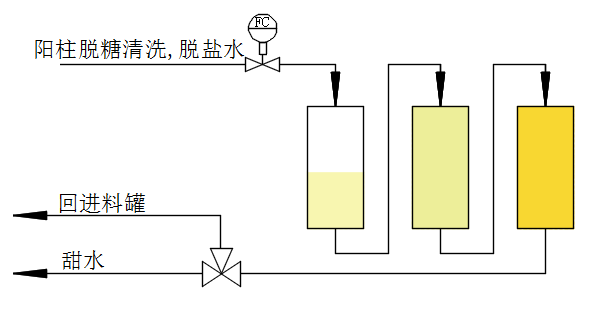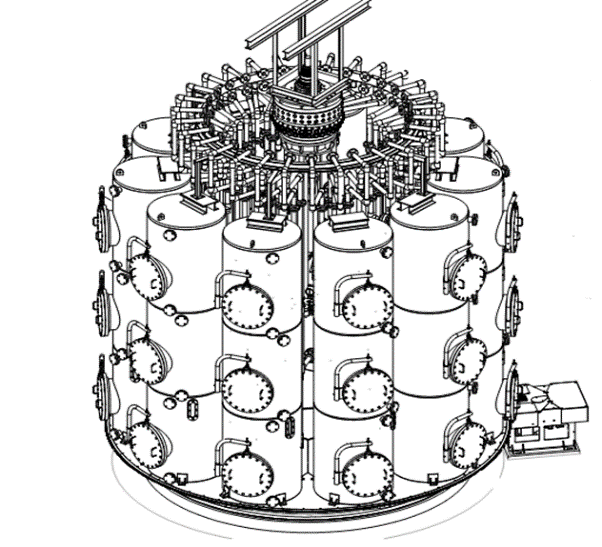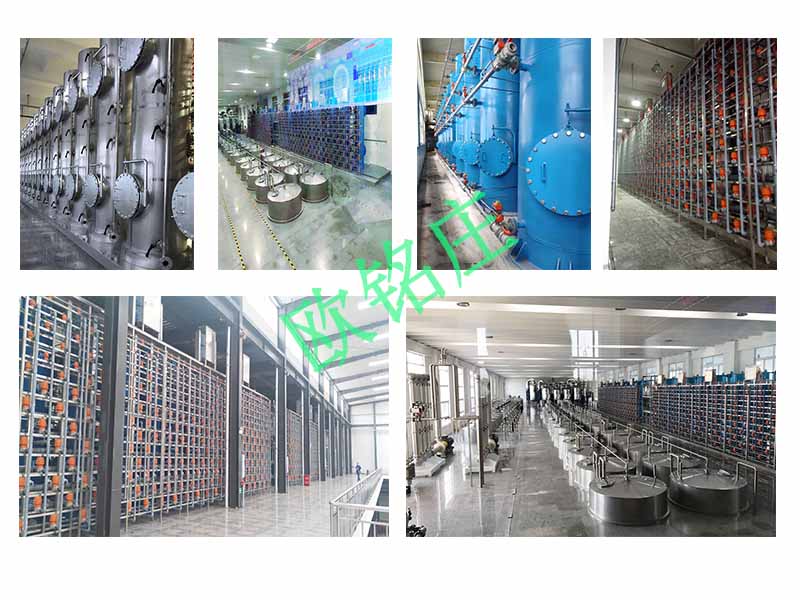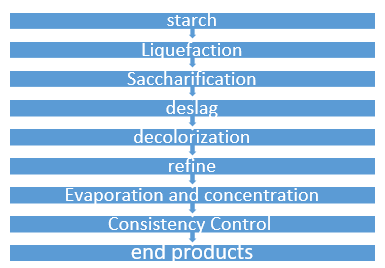产品展示PRODUCTS SHOW
首页>产品展示>Main technologies

Ion Exchange System 2
4 Some advantages of the multi-unit system are as follows


Fig 4-1 The process of sweeting off Fig 4-2 The process flow diagram of resin regeneration and elution
Comparison of water and chemicals consumption in each process for 30 m3/h materials running in different systems
Contrastive items
Fixed bed
Full-chamber bed
Multi-unit system
process
flow
sweet off
m3/h
1.07
1.00
0.14
backwash
m3/h
1.29
1.20
1.39
30% HCL
m3/h
0.12
0.10
0.05
regeneration
m3/h
0.86
0.72
0.00
replacement
m3/h
1.07
1.00
0.52
elution
m3/h
2.57
2.40
1.29
sum
m3/h
6.98
6.42
3.39
Contrastive items
Fixed bed
Full-chamber bed
Multi-unit system
process
flow
sweet off
m3/h
1.25
1.15
0.15
backwash
m3/h
1.50
1.38
1.86
30% NaOH
m3/h
0.14
0.12
0.06
regeneration
m3/h
1.00
0.83
0.00
replacement
m3/h
1.25
1.15
0.54
elution
m3/h
4.00
3.69
1.39
sum
m3/h
9.14
8.32
4
5) Benefit to stable control of product quality
In fixed bed or other large beds systems, the product quality will fluctuate strongly when the column is switched.Such as, concentration, electrical conductivity, transmittance, pH and so on. Correspondingly,multi-unit system can treat materials in parallel. One small saturated column is removed and the other small new column replaces that in time, which has nearly little effect on the whole system. The system running flow and resin switching mode are shown in Fig 4-3

FIG 4-3 The system running flow and resin switching mode
The typical fixed bed and full-chamber bed usually need follow other column to adjust quality. The multi-unit system is so easy to meet demand that processing technology becomes simple and investments are reduced.
6) It is convenient to carry out subsequent expansion with the low investment and short cycle.
The production capacity of typical ion exchange systems depends on the volume of the resin column and the diameter of the pipeline. Their extensibility is bad, and it is difficult to expansion and changing production. Much cost have to be paid for the new equipment. For the multi-unit ion exchange system,to some degree,it is limited by the number of resin columns. So the civil construction location is reserved at the beginning, and the transformation investment will be low.
7) The control is more flexible with the array valve.
The multi-unit continuous ion exchange system is controlled by array valve, which can solve all kinds of technique problems neatly and remove the fault. For different product, it is need to do that not change the connection of the pipeline but the operation mode to match different processes plan. If a certain unit does not work in the system, we remove it out of the system. Once the repairs are completed, the new resin column will work normally without stopping production.
8) High-quality valves are the guarantee of system safety.
①High-quality
The pneumatic diaphragm valve used in the system is imported from Switzerland. Its service life is 250,000 times.The system operates with an opening and closing cycle of about two hours per valve, so it switches on and off less than 50,000 times a decade.
②Few type
There are generally only two types of valves in the system, and only two spare valves are required.
③Convenient and secure connection
Valves and pipes are connected by unions, so it is more convenient to replace than other connection.
9) The operation is more sophisticated.
The multi-unit continuous ion exchange system with array valves can be controlled more flexibly compared to other continuous ion exchange system. The elution process can be divided into three steps such as quick washing, slow washing and stopping washing, which can meet the requirements of the refined operation of the system. Therefore, the effection is better.
5 Advantages over ISEP

FIG 5-1 ISEP
ISEP system consists of a distribution valve with many slots and mechanical rotating.The fluid enters the different resin column through the distribution valve to get convection. The traditional fixed bed is divided into several small column, then the mechanical rotating turns them, so as to convert the traditional fixed bed to run continuous moving bed. And its separation efficiency is improved greatly.The rotary valve, mechanical rotating and control system have a synergetic relationship in ISEP, which can lead to convenience in installation and maintenance.
Some advantages of multi-unit continuous ion exchange system with array valves areas follows.
1) It controls valve to switch resin column, which is more stable. For example, the flow and pressure ranges are almost constant.
2) Reliable valves ensure the normal and continuous operation of the system.And every valve in the system has feedback and linkage.
3) The valve could be switched on and off if within certain operating authority. The fault handling more flexible.
4)Step switch and flow parameters can be set, so the process operation is more sophisticated. For example, the rinse steps can be set to quick and slow.
5)The subsequent expansion is simple, and the investment of transformation is small.
6)The structure of the system is simple, and the investment cost is low. In addition,it avoids the ISEP shaft and seal damage problems.
6 Examples of project
The multi-unit continuous ion exchange system with array valves have been widely used in the production line of corn starch, maltodextrin, maltose, dextrose monohydrate, dextroseanhydrous, HFCS, crystalline fructose, sodium gluconate and a variety of organic acids.

FIG 6-2 Production flow chart of maltose

FIG 6-3 Operating state
Liquefactio
【上一个】 Ion Exchange System 1






